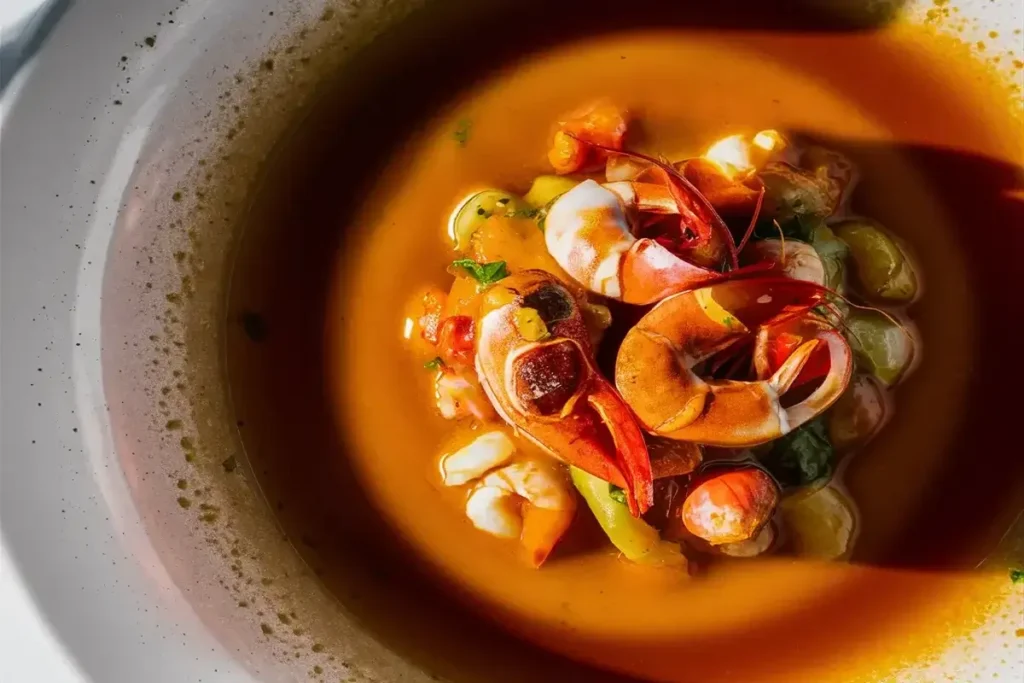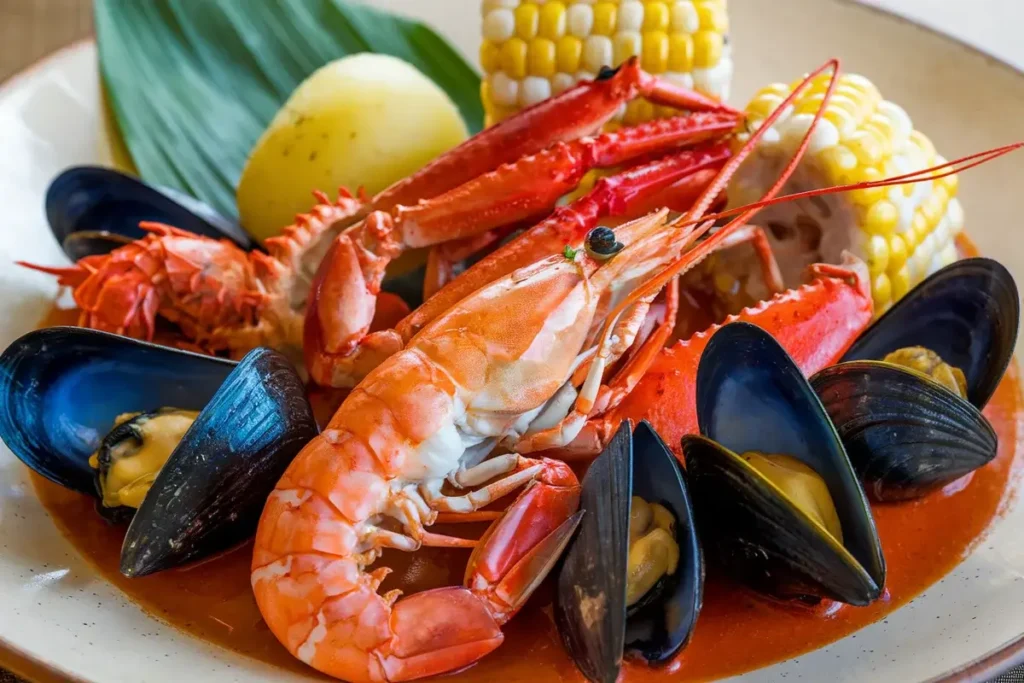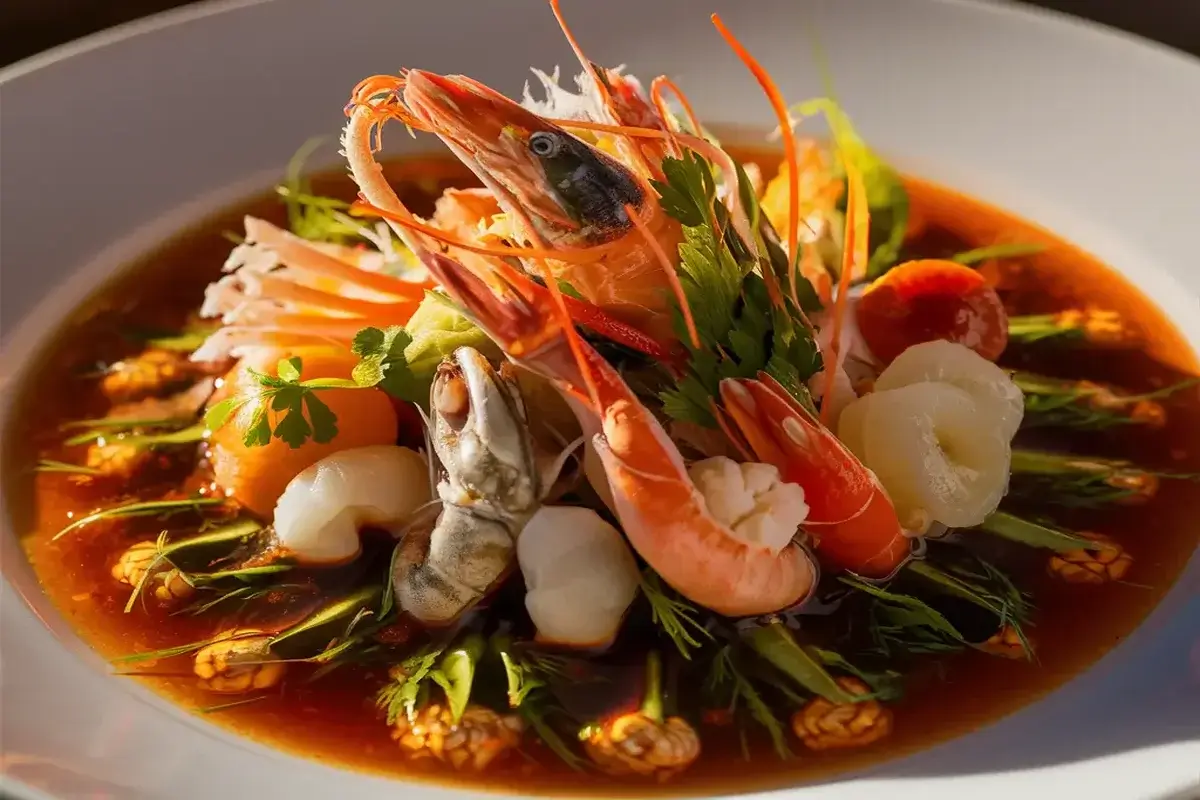Seafood boil sauce is an essential element that elevates any seafood boil. Whether you’re preparing a Southern-style boil with shrimp, crab, lobster, or crawfish, this rich, flavorful sauce is the key to turning a simple seafood dish into something spectacular. In this article, we’ll explore what seafood boil sauce is made of, the most popular ingredients, and how you can create your own version at home.
Introduction to Seafood Boil Sauce
Seafood boil sauce is a buttery, spicy, and aromatic sauce used to complement a variety of seafood dishes. The sauce originated in Southern coastal regions, particularly in Cajun and Creole cooking, where seafood boils are a beloved communal tradition. Not only does the sauce add depth and flavor to seafood, but it’s also perfect for dipping vegetables like corn and potatoes, which often accompany the meal.
The beauty of seafood boil sauce lies in its customizability. You can make it as simple or complex as you like, depending on your personal taste and the spices you have on hand. What stays consistent, though, is the base of butter and garlic, which serves as the foundation for most seafood boil sauces.
Core Ingredients of Seafood Boil Sauce
The base of any good seafood boil sauce is its core ingredients. These are the building blocks that bring out the best in your seafood. Let’s dive into the fundamental components:
Butter
Butter is the heart of seafood boil sauce. It provides a rich, creamy texture that coats the seafood beautifully, allowing the sauce to cling to every bite. Unsalted butter is often preferred, as it allows for better control over the saltiness of the dish. However, salted butter can work just as well, depending on your preference. For more on how butter creates a perfect sauce, read here.
Garlic
Garlic is a must-have in any seafood boil sauce. Its strong, pungent flavor adds depth and enhances the natural sweetness of the seafood. You can use fresh minced garlic for a sharp, aromatic kick, or opt for garlic powder if you want a subtler flavor.
Onions
Onions contribute a sweet, savory flavor to the sauce. Depending on what you have on hand, you can use yellow, white, or even red onions. Finely diced onions are typically sautéed in butter at the beginning of the cooking process, allowing them to caramelize and release their natural sugars.
Lemon or Citrus
Citrus adds a fresh, tangy acidity that balances out the richness of the butter and the heat from the spices. Lemon juice is the most commonly used, but lime or even orange zest can be a fun twist. The acidity helps to cut through the fat and enhances the overall flavor of the seafood boil sauce. To learn more about the benefits of lemon seasoning, check out this article.
Popular Spice Blends for Seafood Boil Sauce
Spices are where you can really make this sauce your own. Several popular spice blends can be used in a seafood boil sauce, adding various layers of flavor.
Old Bay Seasoning
Old Bay Seasoning is one of the most recognizable spice blends in seafood cooking. It’s a classic choice for many seafood boil sauces because of its balance of cayenne pepper, celery salt, and paprika. Its subtle heat and savory undertones make it an easy go-to for any seafood dish. Learn more about Old Bay and its history.
Cajun Seasoning
For a more intense, peppery heat, Cajun seasoning is an excellent choice. This blend typically includes paprika, garlic powder, cayenne pepper, and oregano, bringing a bold, spicy kick to the sauce. Many seafood lovers appreciate the vibrant heat of Cajun seasoning, which is a staple in Louisiana-style cooking.
Creole Seasoning
Creole seasoning offers a slightly milder, more herbaceous flavor compared to Cajun blends. It combines similar spices like paprika and cayenne but often includes herbs like thyme and parsley, providing a more balanced taste. Creole seasoning is perfect for those who want a flavorful, spicy sauce without overwhelming heat.
Custom Spice Mixes
If you’re feeling adventurous, you can create your own spice blend. Start with a base of paprika, cayenne pepper, garlic powder, and onion powder, then experiment with herbs like oregano, thyme, or even bay leaves. Adjust the spice levels to suit your taste. This allows you to personalize the sauce to make it truly your own.
Optional Ingredients for Seafood Boil Sauce

While the core ingredients make up the foundation of a delicious seafood boil sauce, there are several optional ingredients that can elevate your sauce even further. These additions are entirely up to your personal taste.
Hot Sauce
If you enjoy some serious heat, hot sauce is a must. There are various hot sauces to choose from, with Tabasco being a popular choice for seafood boils. Hot sauce not only brings heat but also adds a layer of tanginess. You can control the spice level by adjusting the amount of hot sauce added.
Worcestershire Sauce
For a savory depth of flavor, Worcestershire sauce adds an umami note that enhances the richness of the butter and garlic. Just a splash is enough to transform your sauce from simple to complex. If you don’t have Worcestershire sauce on hand, soy sauce or fish sauce can serve as a substitute.
Beer or Broth
Adding a liquid like beer or broth can help thin out the sauce while adding another dimension of flavor. Beer adds a slight bitterness, while chicken or seafood broth offers a savory base. Both are excellent choices depending on the flavor profile you’re aiming for.
Brown Sugar or Honey
A touch of sweetness can balance out the heat from the spices and the acidity from the citrus. Adding brown sugar or honey helps round out the flavor, giving the sauce a rich, complex taste. Alternatively, molasses can be used for an even deeper sweetness.
Cooking Method for Seafood Boil Sauce
Now that you know the essential ingredients, let’s dive into how to bring them together to make the perfect seafood boil sauce.
Melting and Combining Ingredients
Start by melting the butter in a large pan over medium heat. Once the butter is fully melted, add the minced garlic and onions, cooking until they become fragrant and translucent. This process usually takes around 3-5 minutes. Be sure to stir constantly so the garlic doesn’t burn, as burnt garlic can give the sauce a bitter taste.
Simmering the Sauce
Once the garlic and onions are sautéed, it’s time to add your spice blend. Whether you’re using Old Bay, Cajun, or Creole seasoning, sprinkle it into the pan and stir well. You’ll want to simmer the sauce for about 10-15 minutes, allowing the spices to meld together with the butter, garlic, and onions.
Adjusting for Taste
As your sauce simmers, taste it periodically. This is where you can adjust for saltiness, spiciness, or acidity. If it’s too rich, add more lemon juice to brighten it up. If it’s too spicy, consider adding more butter or a splash of broth to tone it down. Keep stirring the sauce until all ingredients are well-combined and the flavors have deepened.
Now that we’ve covered the essentials of the ingredients and preparation method for seafood boil sauce, let’s explore the remaining aspects, including how to serve the sauce, variations you can try, and tips for perfecting your recipe. This will give you a deeper understanding of the sauce and how it can enhance your next seafood boil.
Serving Suggestions for Seafood Boil Sauce
There are several ways to use this rich and flavorful sauce with your seafood boil, each offering a slightly different experience. Here are some popular methods:
Using the Sauce as a Dip
Many people prefer to serve seafood boil sauce as a dipping sauce. This allows you to savor each bite with the perfect amount of sauce, particularly when eating shellfish like shrimp, crab, or lobster. To serve as a dip, keep the sauce warm in individual bowls. Its buttery consistency will cling to the seafood, ensuring a satisfying taste in every bite.
Pouring Over the Boil
Another method is to pour the sauce directly over your boiled seafood, ensuring that every piece is evenly coated. This method works especially well for larger seafood boils, where you want the flavors to infuse the entire dish. After pouring the sauce, toss the seafood gently to distribute it evenly.
Don’t Forget the Vegetables
Seafood boil sauce isn’t just for seafood. It works beautifully with the vegetables traditionally served with boils, such as corn, potatoes, and mushrooms. Drizzling the sauce over the veggies can enhance their flavor and make them as enjoyable as the seafood itself.
Experimenting with Variations
While the classic seafood boil sauce is delicious, you can create many variations to suit your personal taste or dietary preferences. Here are some ways to switch things up:
Spicy Garlic Butter
For those who love heat, you can increase the amount of hot sauce, cayenne pepper, or red pepper flakes. This turns your sauce into a spicy garlic butter that adds an exciting punch to the dish. Be sure to adjust the heat to your liking—it’s easy to customize by adding a little more or less spice.
Zesty Lemon Twist
For a lighter, fresher take on the sauce, add extra lemon juice or zest. This brings out a bright citrus note that pairs well with lighter seafood like shrimp or scallops. A lemon-forward sauce can add a zesty pop that balances the richness of the butter.
Herb-Infused Butter Sauce
Fresh herbs like parsley, thyme, or oregano can add a unique twist to your seafood boil sauce. This option works particularly well when serving crab legs or white fish. The herbs not only enhance the aroma but also give the sauce a fresh, earthy flavor.
Vegan or Dairy-Free Option
If you’re catering to a plant-based diet, don’t worry—seafood boil sauce can still be made delicious without butter. Substitute plant-based butter or olive oil, and swap Worcestershire sauce for a vegan alternative like soy sauce. The result is just as tasty and indulgent.
Health Benefits of Key Ingredients

Seafood boil sauce may seem indulgent, but some of its core ingredients also offer significant health benefits. Let’s take a look at a few of them:
Garlic’s Immune-Boosting Properties
Garlic is known for its powerful health benefits. It contains compounds like allicin, which have been shown to boost immune function, lower blood pressure, and improve cholesterol levels. Garlic also acts as an antioxidant, protecting the body from oxidative stress.
Vitamin C from Lemon
Lemon juice is rich in vitamin C, which supports the immune system and helps the body absorb iron more effectively. In seafood boil sauce, lemon not only adds acidity but also provides a nutritional boost, making it a healthier addition to your meal.
Anti-Inflammatory Spices
Spices like cayenne pepper and paprika aren’t just for flavor—they also have anti-inflammatory properties. Capsaicin, found in cayenne, can help reduce inflammation and improve circulation. Additionally, these spices are rich in antioxidants, which help combat free radicals in the body.
Tips for Making the Perfect Seafood Boil Sauce
Even with a simple recipe, a few tips can help you achieve the best results when making seafood boil sauce. Here’s how to ensure your sauce is a hit every time:
Achieving a Balance of Flavors
The perfect sauce is all about balance. If your sauce tastes too rich, a splash of lemon juice can help brighten it up. If it’s too spicy, more butter or broth can help mellow the heat. Taste your sauce as you go and make adjustments to ensure all the flavors are working together.
Experiment with Ingredients
Don’t be afraid to get creative with your sauce! You can add a variety of ingredients like smoked paprika for a deeper flavor or a splash of soy sauce for umami. You can also switch up the base—using ghee instead of butter will give the sauce a nuttier flavor, while olive oil provides a lighter alternative.
Storing Leftovers
If you have leftover sauce, it can be stored in the refrigerator for up to a week. Simply place it in an airtight container. When you’re ready to use it again, gently reheat the sauce on low to maintain its texture and flavor.
Conclusion
Seafood boil sauce is more than just a dipping sauce—it’s an essential component that enhances the flavor of the seafood and vegetables in a boil. With a combination of butter, garlic, and spices, you can create a rich, flavorful sauce that suits your taste preferences. Whether you prefer a zesty lemon version or a spicy Cajun twist, this sauce can be tailored to any seafood boil and bring the dish to life.
FAQs
- Can I Make Seafood Boil Sauce in Advance?
Yes, you can prepare the sauce in advance and store it in the fridge for up to a week. Reheat it on low before serving to maintain its flavor and texture.
- How Do I Store Leftover Sauce?
Leftover sauce can be refrigerated in an airtight container for up to a week. If you need to store it longer, freezing is also an option.
- What’s the Best Way to Reduce Spice in the Sauce?
To make the sauce less spicy, you can add more butter or broth to dilute the heat. Another option is to reduce the amount of cayenne or hot sauce in the recipe.
- Can This Sauce Be Used for Non-Seafood Dishes?
Absolutely! Seafood boil sauce is versatile enough to be used with vegetables, chicken, or even steak. Its buttery, garlicky flavor complements many dishes.
- What Type of Butter Should I Use?
Unsalted butter is ideal for this recipe because it allows for more control over the seasoning. However, salted butter can also be used—just adjust the additional salt in the sauce accordingly.

